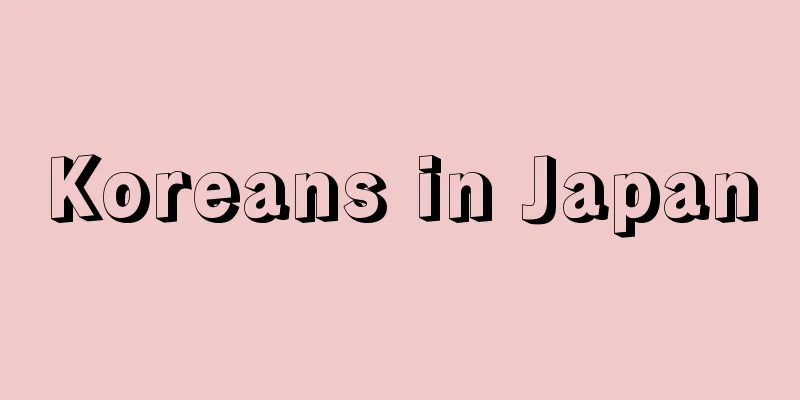Koreans in Japan

|
Korea, which was a Japanese colony, became two nations in 1948 after the war: the Democratic People's Republic of Korea (North Korea) and the Republic of Korea (South Korea). As of the end of 1993, there were approximately 680,000 Koreans living in Japan, accounting for 51.6% of the foreigners in Japan. The majority were either forced to emigrate to Japan due to colonial rule, or were forcibly taken as laborers and had no choice but to stay in Japan, or their descendants. Until the San Francisco Peace Treaty came into effect in 1952, the Japanese government considered Koreans in Japan to have Japanese nationality, but at the same time adopted a dual policy of applying the Alien Registration Act. Since 1952, they have been subject to the Immigration Control Act (now the Immigration Control and Refugee Recognition Act) and the Alien Registration Act, and have also implemented assimilation policies, including encouraging naturalization. During that time, approximately 93,000 Koreans have returned to North Korea since 1959 under the Agreement on the Repatriation of Koreans in Japan. After the Japan-Korea Treaty was concluded in 1965, the agreement on legal status allowed only those with Korean nationality to obtain permanent residency, but excluded those with North Korean nationality (Koreans in Japan who did not switch to Korean nationality). A legal amendment in 1982 allowed special permanent residency regardless of nationality only to those who had lived in Japan since before the war, but the Immigration Control and Refugee Recognition Act of 1989 (linked to the ratification of the Refugee Convention) granted new permanent residency and applied the principle of equality between Japanese and foreigners in the social security system. As a result of the opposition movement in the 1980s, the fingerprinting requirement for alien registration was changed to a one-time requirement in 1987, and was abolished for special permanent residents and permanent residents in 1992, and was completely abolished in 1999. In the 1990s, the number of people naturalizing increased, and the number of people marrying Japanese nationals exceeded 80%. Organizations of Korean residents in Japan include the Korean Residents Union in Japan (Korean Mindan), the General Association of Korean Residents in Japan (Chongryon), and the Japan Headquarters of the National Council for the Restoration of Democracy and Promotion of Unification of Korea (Korean Mindan), which was formed in 1973 by anti-mainstream Mindan faction. → Related topics Voting rights for foreigners | Kyowakai | Kim Hak-young | Jeju Island | Creation of a new name | Koreans | Korea University | Japan-Korea talks | Lee Hui-seong Source : Heibonsha Encyclopedia About MyPedia Information |
|
日本の植民地であった朝鮮は戦後1948年に朝鮮民主主義人民共和国(北朝鮮),大韓民国(韓国)の2国家となったが,朝鮮人で日本に在住するものは1993年末現在約68万人で,在日外国人の51.6%を占める。大多数は植民地支配により日本への移住を余儀なくされたか,労働力として強制連行され,日本に在留せざるを得なくなった者およびその子孫。日本政府は1952年のサンフランシスコ講和条約発効まで在日朝鮮人を日本国籍保有者とみなしたが,同時に外国人登録令を適用する二重政策をとった。1952年以降は出入国管理令(現,出入国管理および難民認定法),外国人登録法の適用対象とし,また帰化奨励を含む同化政策を併用してきた。その間1959年以降〈在日朝鮮人帰還協定〉により約9万3000人が北朝鮮に帰還した。1965年の日韓条約締結後,その法的地位協定により,韓国籍の者にかぎり永住権の取得が認められたが,朝鮮籍(韓国籍に切り替えなかった在日朝鮮人)のものは除外されていた。1982年の法改正により戦前からの居住者にかぎり国籍をとわず特例永住権が認められたが,1989年〈出入国管理および難民認定法〉(難民条約批准と連動)に伴う新たな永住権付与と社会保障制度における内外人平等原則の適用が行われるようになった。外国人登録の〈指紋押捺〉も1980年代の反対運動の結果,1987年に1回制とされ,1992年〈特別永住者〉と〈永住者〉については廃止され,1999年には全廃された。1990年代には帰化する者が増え,日本人との結婚も80%を超える状況となっている。在日朝鮮人の団体としては在日本大韓民国民団(韓国民団),在日本朝鮮人総連合会(朝鮮総連),1973年に民団反主流派によって結成された韓国民主回復・統一促進国民会議日本本部(韓民統)などがある。 →関連項目外国人参政権|協和会|金鶴泳|済州島|創氏改名|朝鮮人|朝鮮大学校|日韓会談|李恢成 出典 株式会社平凡社百科事典マイペディアについて 情報 |
<<: Agreement on the Repatriation of Korean Nationals in Japan
Recommend
Helvétius, Claude Adrien
Born: January 26, 1715, Paris Died December 26, 17...
Milk homogenization - Milk homogenization
...It is produced and secreted from the mammary g...
Rikugien Garden
Located in Honkomagome 6-chome, Bunkyo-ku, Tokyo,...
Davis, T.
…an organization that aimed for the independence ...
Kircher Museum
During this time, he restored the ancient Aeolian...
political question
...refers to acts of a state that have a highly p...
Ahbar - Ahbar
...They also do not accept any ijma (consensus) a...
Shimose explosives (English spelling)
A military explosive that was adopted as the offi...
Kazan'
It is the capital of the Republic of Tatarstan in ...
credenza
…Early medieval cupboards were made of thick wood...
Male ant - Male ant
…There are characteristics such as the existence ...
Narrow visibility navigation
…General navigation is further divided into three...
Pearson, RG (English spelling)
…Hard acids and bases, and soft acids and bases, ...
Ashikaga Prefectural Natural Park
A natural park in the southwest of Tochigi Prefect...
Kubota Utsubo
Poet and Japanese literature scholar. Born on Jun...









